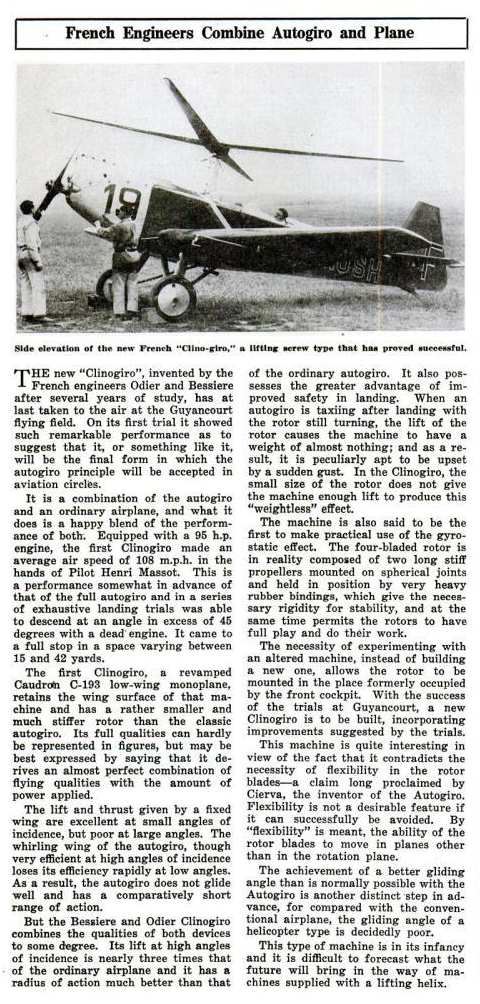- Joined
- 25 June 2009
- Messages
- 14,141
- Reaction score
- 4,333
Aircraft builder and inventor Antoine Odier co-founded in 1930 with engineer Gustave Bessière (also a respected mathematician and inventor of famous grenade) the Ecole Spéciale des Travaux Aéronautiques (E.S.T.A.) — along with engineer general Louis Jauch. The following year, the two men devised a new type of machine, the Clinogyre, which was sort of halfway between an aircraft and an autogyro.
Two prototypes were made, modified from two Caudron C.193 airframes (a type which was known for its recent participation in the "Tour d'Europe") on which two coaxial rotors were grafted, each propeller having only two blades and a 6-meter diameter. They were registered F-AJSH and F-AJSJ, and owned by Société des Usines Renault and René Caudron, respectively.
Ground testing took place in 1931 at the Institut aérotechnique in Saint-Cyr. For ground testing, Odier and Bessière constructed a special electric test bench in the form of an aerodynamic cart that dragged the near-flight-ready machine on rails at speeds up to 128km/h (80 miles per hour). The installation was also fitted with a range of measuring equipment, under the supervision of a dedicated research engineer. Flight tests ensued in the Spring of 1932 at Guyancourt, where the aircraft reached speeds of 165 km/h.
The name "Clinogyro" used by its inventors to describe the aircraft was coined to underline the fact that it used a unique rotor arrangement that differentiated it from the contemporary autogyros. Contrary to La Cierva's "Autogiro", the rotor blades were not fully articulated but were capable of moving slightly away from each other. They would flap thanks to the placement of rubber pads between the rotors and the plates of the hub. These pads were also used for elastic coupling, which was also dubbed "Flector."
The rotor blades were also special in having a marked negative warp towards the axle and a slightly positive warp towards the tips. The inner part would function like a normal aircraft propeller and make the engine run, while the outer part worked like the blades of a helicopter's rotor. These peculiar blades were likened to a cockchafer's combination of flapping wings and fixed elytra. The Clinogyro's rotor arrangement could supposedly be fitted to any low wing monoplane aircraft.
While a fixed wing performed well at small angles but was dangerous at high incidence, a rotary wing was just the opposite. The combination of the two supposedly made for a much safer machine. With regards to the initial airframe, the Clinogyre had a very flattened polar, and while the original type would stall at 16°, the modified type's lift would decrease from a 25° incidence. Maximum speed was slightly inferior to the 193 km/h of the original, but minimum speed fell down to 40 km/h and allowed for 45° descents.
Like other contemporary machines that explored alternative configurations between the aircraft and the rotorcraft (Herrick's Vertoplane, notably, comes to mind) it sadly failed to find its place. Despite such interesting performance, the military showed no interest in the project, and the "Clinogyro" did not go beyond the prototype stage.
Researched and written by Stéphane BEAUMORT
Main sources:
- L’aéronautique N°160 septembre 1932
- La Nature N°2872, 1er janvier 1932
- La Nature N°2884, 1er juillet 1932
- More on Antoine Odier: https://patrimoine.gadz.org/gadz/odier.htm
- More on the technology behind the Clinogyro: http://jeancousin4923.wordpress.com/2009/02/12/la-variation-d-incidence-aerodynamique/
- An article in Russian: http://strangernn.livejournal.com/712402.html











